十条华为交换机命令最基本的用法
- 格式:doc
- 大小:16.50 KB
- 文档页数:3

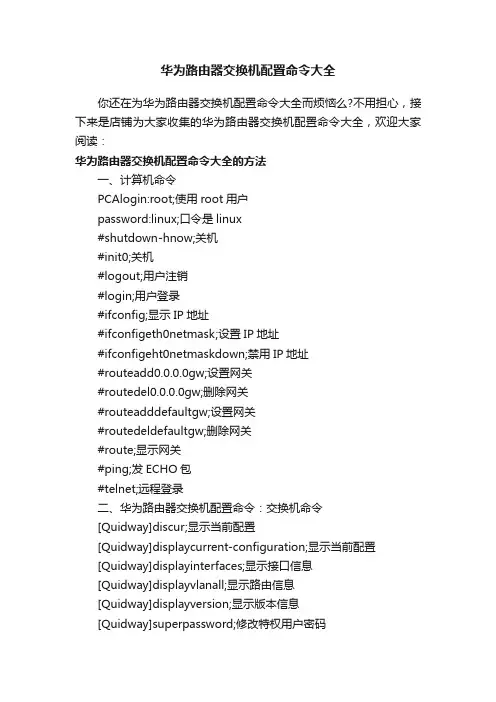
华为路由器交换机配置命令大全你还在为华为路由器交换机配置命令大全而烦恼么?不用担心,接下来是店铺为大家收集的华为路由器交换机配置命令大全,欢迎大家阅读:华为路由器交换机配置命令大全的方法一、计算机命令PCAlogin:root;使用root用户password:linux;口令是linux#shutdown-hnow;关机#init0;关机#logout;用户注销#login;用户登录#ifconfig;显示IP地址#ifconfigeth0netmask;设置IP地址#ifconfigeht0netmaskdown;禁用IP地址#routeadd0.0.0.0gw;设置网关#routedel0.0.0.0gw;删除网关#routeadddefaultgw;设置网关#routedeldefaultgw;删除网关#route;显示网关#ping;发ECHO包#telnet;远程登录二、华为路由器交换机配置命令:交换机命令[Quidway]discur;显示当前配置[Quidway]displaycurrent-configuration;显示当前配置[Quidway]displayinterfaces;显示接口信息[Quidway]displayvlanall;显示路由信息[Quidway]displayversion;显示版本信息[Quidway]superpassword;修改特权用户密码[Quidway]sysname;交换机命名[Quidway]interfaceethernet0/1;进入接口视图[Quidway]interfacevlanx;进入接口视图[Quidway-Vlan-interfacex]ipaddress10.65.1.1255.255.0.0;配置VLAN的IP地址[Quidway]iproute-static0.0.0.00.0.0.010.65.1.2;静态路由=网关[Quidway]rip;三层交换支持[Quidway]local-userftp[Quidway]user-interfacevty04;进入虚拟终端[S3026-ui-vty0-4]authentication-modepassword;设置口令模式[S3026-ui-vty0-4]setauthentication-modepasswordsimple222;设置口令[S3026-ui-vty0-4]userprivilegelevel3;用户级别[Quidway]interfaceethernet0/1;进入端口模式[Quidway]inte0/1;进入端口模式[Quidway-Ethernet0/1]duplex{half|full|auto};配置端口工作状态[Quidway-Ethernet0/1]speed{10|100|auto};配置端口工作速率[Quidway-Ethernet0/1]flow-control;配置端口流控[Quidway-Ethernet0/1]mdi{across|auto|normal};配置端口平接扭接[Quidway-Ethernet0/1]portlink-type{trunk|access|hybrid};设置端口工作模式[Quidway-Ethernet0/1]portaccessvlan3;当前端口加入到VLAN [Quidway-Ethernet0/2]porttrunkpermitvlan{ID|All};设trunk 允许的VLAN[Quidway-Ethernet0/3]porttrunkpvidvlan3;设置trunk端口的PVID[Quidway-Ethernet0/1]undoshutdown;激活端口[Quidway-Ethernet0/1]shutdown;关闭端口[Quidway-Ethernet0/1]quit;返回[Quidway]vlan3;创建VLAN[Quidway-vlan3]portethernet0/1;在VLAN中增加端口[Quidway-vlan3]porte0/1;简写方式[Quidway-vlan3]portethernet0/1toethernet0/4;在VLAN中增加端口[Quidway-vlan3]porte0/1toe0/4;简写方式[Quidway]monitor-port;指定镜像端口[Quidway]portmirror;指定被镜像端口[Quidway]portmirrorint_listobserving-portint_typeint_num;指定镜像和被镜像[Quidway]descriptionstring;指定VLAN描述字符[Quidway]description;删除VLAN描述字符[Quidway]displayvlan[vlan_id];查看VLAN设置[Quidway]stp{enable|disable};设置生成树,默认关闭[Quidway]stppriority4096;设置交换机的优先级[Quidway]stproot{primary|secondary};设置为根或根的备份[Quidway-Ethernet0/1]stpcost200;设置交换机端口的花费[Quidway]link-aggregatione0/1toe0/4ingress|both;端口的聚合[Quidway]undolink-aggregatione0/1|all;始端口为通道号[SwitchA-vlanx]isolate-user-vlanenable;设置主vlan[SwitchA]isolate-user-vlansecondary;设置主vlan包括的子vlan[Quidway-Ethernet0/2]porthybridpvidvlan;设置vlan的pvid [Quidway-Ethernet0/2]porthybridpvid;删除vlan的pvid[Quidway-Ethernet0/2]porthybridvlanvlan_id_listuntagged;设置无标识的vlan如果包的vlanid与PVId一致,则去掉vlan信息.默认PVID=1。

华为路由器交换机常用命令一、设备管理命令1.登录管理命令- ssh [ip地质] -p [端口号]:通过SSH协议登录设备。
- telnet [ip地质]:通过Telnet协议登录设备。
- logout:退出设备。
2.用户管理命令- display current-configuration:显示当前设备配置信息。
- save:保存当前配置。
- undo save:取消保存的配置。
- super:切换到超级用户模式。
- user-interface console 0:配置控制台终端的参数。
- user-interface vty 0 4:配置远程登录终端的参数。
3.设备操作命令- reboot:重启设备。
- reset saved-configuration:恢复出厂配置。
- display version:显示设备的硬件和软件版本信息。
- display device:显示设备的基本信息。
- display interface[接口名称]:显示指定接口信息。
- display ip routing-table:显示IP路由表信息。
二、网络配置命令1.IP配置命令- interface [接口名称]:进入指定接口。
- ip address [IP地质] [子网掩码]:配置接口IP地质。
- undo ip address:取消接口IP地质配置。
- ip route-static [目标网络] [子网掩码] [下一跳地质]:配置静态路由。
- undo ip route-static [目标网络] [子网掩码] [下一跳地质]:取消静态路由配置。
2.VLAN配置命令- vlan [VLAN ID]:创建指定VLAN。
- quit:退出VLAN配置模式。
- interface vlan [VLAN ID]:进入指定VLAN接口。
- ip address [IP地质] [子网掩码]:为VLAN接口配置IP地质。
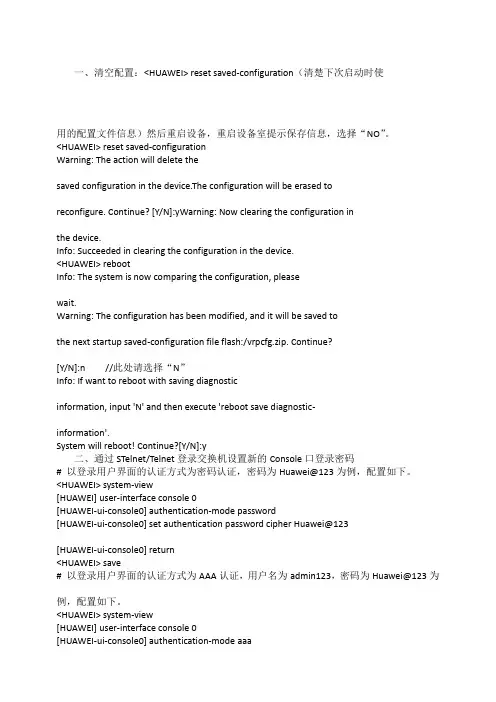
一、清空配置:<HUAWEI> reset saved-configuration(清楚下次启动时使用的配置文件信息)然后重启设备,重启设备室提示保存信息,选择“NO”。
<HUAWEI> reset saved-configurationWarning: The action will delete thesaved configuration in the device.The configuration will be erased toreconfigure. Continue? [Y/N]:yWarning: Now clearing the configuration inthe device.Info: Succeeded in clearing the configuration in the device.<HUAWEI> rebootInfo: The system is now comparing the configuration, pleasewait.Warning: The configuration has been modified, and it will be saved tothe next startup saved-configuration file flash:/vrpcfg.zip. Continue?[Y/N]:n //此处请选择“N”Info: If want to reboot with saving diagnosticinformation, input 'N' and then execute 'reboot save diagnostic-information'.System will reboot! Continue?[Y/N]:y二、通过STelnet/Telnet登录交换机设置新的Console口登录密码# 以登录用户界面的认证方式为密码认证,密码为Huawei@123为例,配置如下。
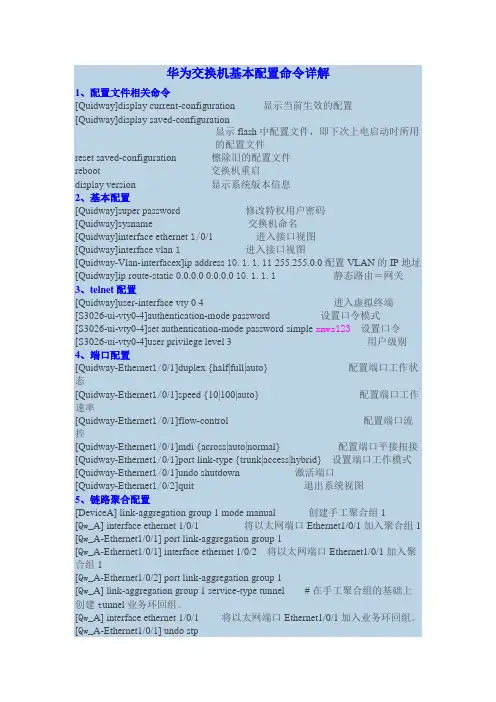
华为交换机基本配置命令详解1、配置文件相关命令[Quidway]display current-configuration 显示当前生效的配置[Quidway]display saved-configuration显示flash中配置文件,即下次上电启动时所用的配置文件reset saved-configuration 檫除旧的配置文件reboot 交换机重启display version 显示系统版本信息2、基本配置[Quidway]super password 修改特权用户密码[Quidway]sysname 交换机命名[Quidway]interface ethernet 1/0/1 进入接口视图[Quidway]interface vlan 1进入接口视图[Quidway-Vlan-interfacex]ip address 10.1.1.11 255.255.0.0配置VLAN的IP地址[Quidway]ip route-static 0.0.0.0 0.0.0.0 10.1.1.1静态路由=网关3、telnet配置[Quidway]user-interface vty 0 4 进入虚拟终端[S3026-ui-vty0-4]authentication-mode password 设置口令模式[S3026-ui-vty0-4]set authentication-mode password simple xmws123设置口令[S3026-ui-vty0-4]user privilege level 3 用户级别4、端口配置[Quidway-Ethernet1/0/1]duplex {half|full|auto} 配置端口工作状态[Quidway-Ethernet1/0/1]speed {10|100|auto} 配置端口工作速率[Quidway-Ethernet1/0/1]flow-control 配置端口流控[Quidway-Ethernet1/0/1]mdi {across|auto|normal} 配置端口平接扭接[Quidway-Ethernet1/0/1]port link-type {trunk|access|hybrid} 设置端口工作模式[Quidway-Ethernet1/0/1]undo shutdown 激活端口[Quidway-Ethernet1/0/2]quit 退出系统视图5、链路聚合配置[DeviceA] link-aggregation group 1 mode manual 创建手工聚合组1[Qw_A] interface ethernet 1/0/1 将以太网端口Ethernet1/0/1加入聚合组1 [Qw_A-Ethernet1/0/1] port link-aggregation group 1[Qw_A-Ethernet1/0/1] interface ethernet 1/0/2 将以太网端口Ethernet1/0/1加入聚合组1[Qw_A-Ethernet1/0/2] port link-aggregation group 1[Qw_A] link-aggregation group 1 service-type tunnel # 在手工聚合组的基础上创建t unnel业务环回组。
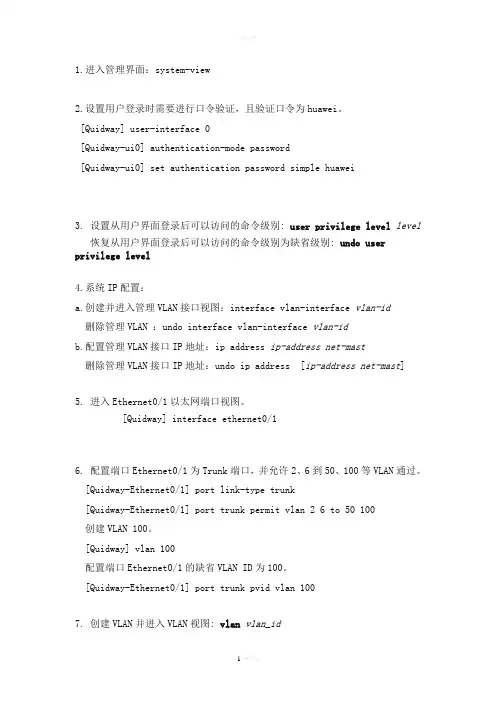
1.进入管理界面:system-view2.设置用户登录时需要进行口令验证,且验证口令为huawei。
[Quidway] user-interface 0[Quidway-ui0] authentication-mode password[Quidway-ui0] set authentication password simple huawei3. 设置从用户界面登录后可以访问的命令级别: user privilege level level恢复从用户界面登录后可以访问的命令级别为缺省级别: undo user privilege level4.系统IP配置:a.创建并进入管理VLAN接口视图:interface vlan-interface vlan-id删除管理VLAN :undo interface vlan-interface vlan-idb.配置管理VLAN接口IP地址:ip address ip-address net-mast删除管理VLAN接口IP地址:undo ip address [ip-address net-mast]5. 进入Ethernet0/1以太网端口视图。
[Quidway] interface ethernet0/16. 配置端口Ethernet0/1为Trunk端口,并允许2、6到50、100等VLAN通过。
[Quidway-Ethernet0/1] port link-type trunk[Quidway-Ethernet0/1] port trunk permit vlan 2 6 to 50 100创建VLAN 100。
[Quidway] vlan 100配置端口Ethernet0/1的缺省VLAN ID为100。
[Quidway-Ethernet0/1] port trunk pvid vlan 1007. 创建VLAN并进入VLAN视图: vlan vlan_id删除已创建的VLAN: undo vlan{ vlan_id [ to vlan_id ] | all }8. 为指定的VLAN增加以太网端口: port interface_list删除指定的VLAN的某些以太网端口: undo port interface_list创建VLAN2并进入其视图。
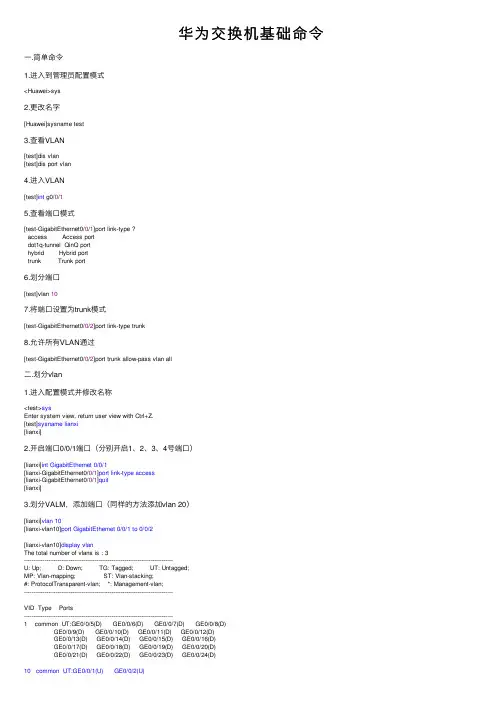
华为交换机基础命令⼀.简单命令1.进⼊到管理员配置模式<Huawei>sys2.更改名字[Huawei]sysname test3.查看VLAN[test]dis vlan[test]dis port vlan4.进⼊VLAN[test]int g0/0/15.查看端⼝模式[test-GigabitEthernet0/0/1]port link-type ?access Access portdot1q-tunnel QinQ porthybrid Hybrid porttrunk Trunk port6.划分端⼝[test]vlan 107.将端⼝设置为trunk模式[test-GigabitEthernet0/0/2]port link-type trunk8.允许所有VLAN通过[test-GigabitEthernet0/0/2]port trunk allow-pass vlan all⼆.划分vlan1.进⼊配置模式并修改名称<test>sysEnter system view, return user view with Ctrl+Z.[test]sysname lianxi[lianxi]2.开启端⼝0/0/1端⼝(分别开启1、2、3、4号端⼝)[lianxi]int GigabitEthernet 0/0/1[lianxi-GigabitEthernet0/0/1]port link-type access[lianxi-GigabitEthernet0/0/1]quit[lianxi]3.划分VALM,添加端⼝(同样的⽅法添加vlan 20)[lianxi]vlan 10[lianxi-vlan10]port GigabitEthernet 0/0/1 to 0/0/2[lianxi-vlan10]display vlanThe total number of vlans is : 3--------------------------------------------------------------------------------U: Up; D: Down; TG: Tagged; UT: Untagged;MP: Vlan-mapping; ST: Vlan-stacking;#: ProtocolTransparent-vlan; *: Management-vlan;--------------------------------------------------------------------------------VID Type Ports--------------------------------------------------------------------------------1 common UT:GE0/0/5(D) GE0/0/6(D) GE0/0/7(D) GE0/0/8(D)GE0/0/9(D) GE0/0/10(D) GE0/0/11(D) GE0/0/12(D)GE0/0/13(D) GE0/0/14(D) GE0/0/15(D) GE0/0/16(D)GE0/0/17(D) GE0/0/18(D) GE0/0/19(D) GE0/0/20(D)GE0/0/21(D) GE0/0/22(D) GE0/0/23(D) GE0/0/24(D)10 common UT:GE0/0/1(U) GE0/0/2(U)20 common UT:GE0/0/3(U) GE0/0/4(U)4.删除vlan[lianxi]undo vlan 10[lianxi]display vlan1 common UT:GE0/0/1(U) GE0/0/2(U) GE0/0/5(D) GE0/0/6(D)GE0/0/7(D) GE0/0/8(D) GE0/0/9(D) GE0/0/10(D)GE0/0/11(D) GE0/0/12(D) GE0/0/13(D) GE0/0/14(D)GE0/0/15(D) GE0/0/16(D) GE0/0/17(D) GE0/0/18(D)GE0/0/19(D) GE0/0/20(D) GE0/0/21(D) GE0/0/22(D)GE0/0/23(D) GE0/0/24(D)20 common UT:GE0/0/3(U) GE0/0/4(U)三.交换机连接[lianxi]int GigabitEthernet 0/0/6[lianxi-GigabitEthernet0/0/6]port link-type trunk #trunk模式[lianxi-GigabitEthernet0/0/6]port trunk allow-pass vlan all #让所有vlan通过四.交换机DHCP分配地址开启DHCP<Huawei>sys[Huawei]dhcp enable #开启DHCP划分vlan[Huawei]vlan 10[Huawei-vlan10]q[Huawei]vl[Huawei]vlan 20[Huawei-vlan20]q[Huawei]进⼊vlan,分配IP地址[Huawei]int vlan 10[Huawei-Vlanif10]ip address 192.168.10.1 24 #为vlan10 分配IP地址[Huawei-Vlanif10]dhcp select interface #在VLAN中开启DHCP[Huawei-Vlanif10]dhcp server dns-list 192.168.10.254 #设置⽹关[Huawei-Vlanif10]dhcp server excluded-ip-address 192.168.10.254 #禁⽌⽹关分配到客户机将0/0/1端⼝划分到VLAN 10中,有[Huawei]int g0/0/1[Huawei-GigabitEthernet0/0/1]port hybrid pvid vlan 10[Huawei-GigabitEthernet0/0/1]port hybrid untagged vlan 10。
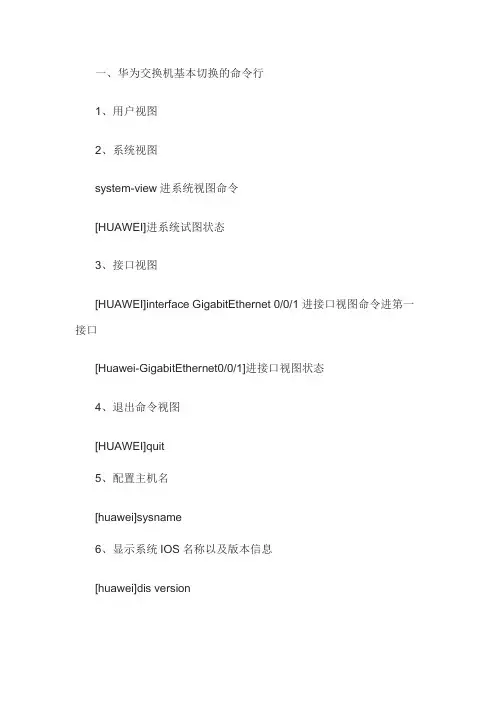
一、华为交换机基本切换的命令行1、用户视图2、系统视图system-view进系统视图命令[HUAWEI]进系统试图状态3、接口视图[HUAWEI]interface GigabitEthernet 0/0/1进接口视图命令进第一接口[Huawei-GigabitEthernet0/0/1]进接口视图状态4、退出命令视图[HUAWEI]quit5、配置主机名[huawei]sysname6、显示系统IOS名称以及版本信息[huawei]dis version7、查看交换机当前配置信息[huawei]display current-configuration8、显示已保存的配置信息[huawei]display saved-configuration9、保存当前配置信息save10、删除已保存的配置信息#reset saved-configuration11、进入接口视图[huawei]interface g0/0/1[huawei-GigabitEthernet]12、配置接口类型[huawei-GigabitEthernet]port link-type access [huawei-GigabitEthernet]port default vlan 213、shutdown命令用来关闭当前接口。
14、undo shutdown命令用来开启当前接口。
15、display interface命令用来查看接口当前运行状态和接口统计信息16、display interface brief命令用来查看接口状态和配置的简要信息。
17、display ip interface brief命令用来查看接口与IP相关的简要信息,包括IP地址、子网掩码、物理链路和协议的Up/Down状态以及处于不同状态的接口数目。
二、划分vlanvlan 2quitintervlan 2ip add 192.168.1.254 24 quitvlan 3quitintervlan 3ip add 192.168.2.254 24 quitinter g0/0/1port link-type access port default vlan 2 quitinter g0/0/2port link-type trunk port trunk all vlan 2 to 3 quit。

华为交换机基本配置命令华为交换机基本配置命令一、单交换机VLAN划分以下是单交换机VLAN划分的基本命令:system:进入系统视图。
system-view:进入系统视图。
quit:退出系统视图。
undovlan20:删除vlan20.XXX:交换机命名。
dispvlan:显示vlan。
vlan20:创建vlan(也可进入vlan20)。
porte1/0/1toe1/0/5:把端口1-5放入VLAN20中。
对于5700系列交换机,单个端口放入VLAN的命令如下:XXX]intg0/0/1XXX]portlink-type access(注:接口类型access,hybrid、trunk)XXX]portdefaultvlan10而批量端口放入VLAN的命令如下:XXX]port-group1XXX-port-group-1]group-XXXXXX-port-group-1]porthybriduntaggedvlan3如果需要删除group(组)vlan200内的15端口,可以使用以下命令:XXX]intg0/0/15XXX-XXX]XXX通过group端口限速设置的命令如下:XXX]Port-group2XXX]group-memberg0/0/2tog0/0/23XXX]qoslroutboundcir2000cbs要显示vlan里的端口20,可以使用以下命令:dispvlan20如果需要进入端口24,可以使用以下命令:inte1/0/24要删除当前VLAN端口10,可以使用以下命令:XXX如果需要显示当前配置,可以使用以下命令:dispcurr如果需要保存配置,可以使用以下命令:save如果需要通过关闭日志信息命令改变DS模块来实现关闭配置后的确认信息显示,可以使用以下命令:info-XXXoff如果需要通过打开日志信息命令改变DS模块来实现打开配置后的确认信息显示,可以使用以下命令:info-XXX二、配置交换机支持XXX以下是配置交换机支持XXX的基本命令:system:进入系统视图。
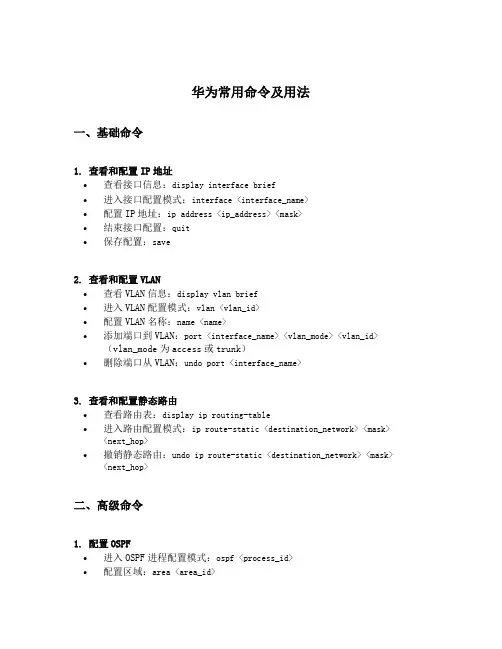
华为常用命令及用法一、基础命令1. 查看和配置IP地址•查看接口信息:display interface brief•进入接口配置模式:interface <interface_name>•配置IP地址:ip address <ip_address> <mask>•结束接口配置:quit•保存配置:save2. 查看和配置VLAN•查看VLAN信息:display vlan brief•进入VLAN配置模式:vlan <vlan_id>•配置VLAN名称:name <name>•添加端口到VLAN:port <interface_name> <vlan_mode> <vlan_id>(vlan_mode为access或trunk)•删除端口从VLAN:undo port <interface_name>3. 查看和配置静态路由•查看路由表:display ip routing-table•进入路由配置模式:ip route-static <destination_network> <mask> <next_hop>•撤销静态路由:undo ip route-static <destination_network> <mask> <next_hop>二、高级命令1. 配置OSPF•进入OSPF进程配置模式:ospf <process_id>•配置区域:area <area_id>•配置区域内路由器:network <network> <mask> [advertise]•配置区域间路由器:area-range <start_address> <end_address>•配置重分布:import-route <protocol> <process_id>•退出OSPF进程配置模式:quit2. 配置ACL•进入ACL配置模式:acl number <acl_number>•配置规则:rule <rule_id> [deny|permit] <source> <destination> [service]•应用ACL:traffic-filter <acl_number> [<in|out>]•退出ACL配置模式:quit3. 配置QoS•进入策略模式:traffic classifier <classifier_name>•配置分类规则:if-match <acl_number>•进入行为模式:traffic behavior <behavior_name>•配置动作:remark <remark_value>•配置队列:queue <queue_id>•应用策略:traffic policy <policy_name>•退出策略模式:quit4. 配置NAT•启用NAT:nat enable•进入NAT地址池配置模式:nat address-group <group_id>•配置地址池:address <start_address> <end_address> [mapping <mapping_address>]•进入ACL配置模式:acl number <acl_number>•配置规则:rule <rule_id> [source <source>] [destination <destination>] [service <service>] [action <action>]•应用NAT:nat policy <acl_number>•退出ACL配置模式:quit三、故障排除命令1. 查看日志•查看系统日志:display logbuffer•根据等级过滤日志:display logbuffer filter-error•清除日志缓冲:clear logbuffer2. 查看接口状态•查看接口状态:display interface <interface_name>•查看接口统计信息:display interface <interface_name> statistics3. 查看路由信息•查看路由表:display ip routing-table•查看OSPF邻居信息:display ospf neighbor•查看BGP邻居信息:display bgp peer4. 远程诊断•进入远程诊断模式:ping•Ping测试:ping <destination_address>•Traceroute测试:tracert <destination_address>•退出远程诊断模式:quit四、安全命令1. 查看用户•查看当前用户:display users•查看用户权限:display aaa2. 配置SSH•进入SSH配置模式:ssh server•启用SSH服务:telnet server enable•配置最大用户数:user-max <max_user>•退出SSH配置模式:quit3. 配置防火墙•开启防火墙:firewall enable•进入防火墙规则配置模式:acl number <acl_number>•配置入站规则:rule <rule_id> [source <source>] [destination <destination>] [service <service>] [action <action>]•配置出站规则:rule <rule_id> [destination <destination>] [source <source>] [service <service>] [action <action>]•应用防火墙策略:firewall policy <acl_number>•退出防火墙规则配置模式:quit以上是华为常用命令及用法的简要介绍,通过掌握这些命令,可以有效地进行网络设备的配置和故障排除工作。
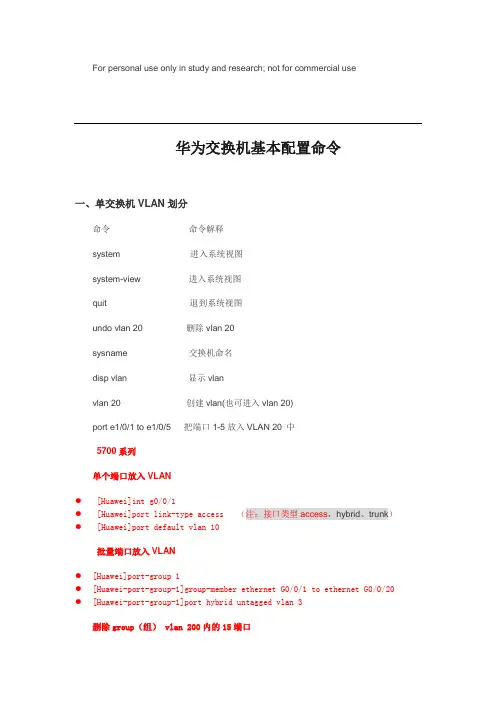
For personal use only in study and research; not for commercial use华为交换机基本配置命令一、单交换机VLAN划分命令命令解释system 进入系统视图system-view 进入系统视图quit 退到系统视图undo vlan 20 删除vlan 20sysname 交换机命名disp vlan 显示vlanvlan 20 创建vlan(也可进入vlan 20)port e1/0/1 to e1/0/5 把端口1-5放入VLAN 20 中5700系列单个端口放入VLAN●[Huawei]int g0/0/1● [Huawei]port link-type access(注:接口类型access,hybrid、trunk)● [Huawei]port default vlan 10批量端口放入VLAN●[Huawei]port-group 1●[Huawei-port-group-1]group-member ethernet G0/0/1 to ethernet G0/0/20 ●[Huawei-port-group-1]port hybrid untagged vlan 3删除group(组) vlan 200内的15端口●[Huawei]int g0/0/15●[Huawei-GigabitEthernet0/0/15]undo port hybrid untagged vlan 200通过group端口限速设置●[Huawei]Port-group 2●[Huawei]group-member g0/0/2 to g0/0/23●[Huawei]qos lr outbound cir 2000 cbs 20000disp vlan 20 显示vlan里的端口20int e1/0/24 进入端口24undo port e1/0/10 表示删除当前VLAN端口10disp curr 显示当前配置●return返回●Save 保存●info-center source DS channel 0 log state off trap state off 通过关闭日志信息命令改变DS模块来实现(关闭配置后的确认信息显示)●info-center source DS channel 0 log state on trap state on 通过打开日志信息命令改变DS模块来实现(打开配置后的确认信息显示)二、配置交换机支持TELNEsystem 进入系统视图sysname 交换机命名int vlan 1 进入VLAN 1ip address 192.168.3.100 255.255.255.0 配置IP地址user-int vty 0 4 进入虚拟终端authentication-mode password (aut password) 设置口令模式set authentication password simple 222 (set aut pass sim 222) 设置口令user privilege level 3(use priv lev 3) 配置用户级别disp current-configuration (disp cur) 查看当前配置disp ip int 查看交换机VLAN IP配置删除配置必须退到用户模式reset saved-configuration(reset saved) 删除配置Reboot 重启交换机三、跨交换机VLAN的通讯在sw1上:vlan 10 建立VLAN 10int e1/0/5 进入端口5port access vlan 10 把端口5加入vlan 10vlan 20 建立VLAN 20int e1/0/15 进入端口15port access vlan 20 把端口15加入VLAN 20int e1/0/24 进入端口24port link-type trunk 把24端口设为TRUNK端口port trunk permit vlan all 同上在SW2上:vlan 10 建立VLAN 10int e1/0/20 进入端口20port access vlan 10 把端口20放入VLAN 10int e1/0/24 进入端口24port link-type trunk 把24端口设为TRUNK端口port trunk permit vlan all (port trunk permit vlan 10 只能为vlan 10使用)24端口为所有VLAN使用disp int e1/0/24 查看端口24是否为TRUNKundo port trunk permit vlan all 删除该句四、路由的配置命令system 进入系统模式sysname 命名int e1/0 进入端口ip address 192.168.3.100 255.255.255.0 设置IPundo shutdown 打开端口disp ip int e1/0 查看IP接口情况disp ip int brief 查看IP接口情况user-int vty 0 4 进入口令模式authentication-mode password(auth pass) 进入口令模式set authentication password simple 222 37 设置口令user privilege level 3 进入3级特权save 保存配置reset saved-configuration 删除配置(用户模式下运行)undo shutdown 配置远程登陆密码int e1/4ip route 192.168.3.0(目标网段)255.255.255.0 192.168.12.1(下一跳:下一路由器的接口)静态路由ip route 0.0.0.0 0.0.0.0 192.168.12.1 默认路由disp ip rout 显示路由列表华3C AR-18E1/0(lan1-lan4)E2/0(wan0)E3/0(WAN1)路由器连接使用直通线。
1、通过AC telnet到交换机(交换机管理IP为:),需要输入交换机的用户名和密码,下图
中用户名为:smxyd,密码为:smxyd;
2、进入交换机特权模式:sys
3、查看交换机端口信息:display interface brief
4、查看交换机各端口连接AP的MAC地址:display mac-address
5、显示当前交换机信息:display current-configuration
6、进交换机端口命令:interface ethernet0/0/28
7、关交换机某个端口,要先进入到某个端口下:shutdown
8、开交换机某个端口,要先进入到某个端口下:undo shutdown
9、开交换机某个端口poe供电功能,要先进入到某个端口下:poe enable
10、关交换机某个端口poe供电功能,要先进入到某个端口下:undo poe enable
11、看交换机所有端口poe供电功能是开还是关:display poe power-state
12、地址解析协议,AP MAC对应的AP ip地址:dis arp
13、返回:quit
14、保存设置:save
15、删除某条命令,一般使用命令:undo。
华为交换机常用指令一、交换机设备登陆及配置:1、设备登陆配置我中心维护汇聚和热点交换机,交换机类型为5300、2300和GPON,交换机使用secure CRT软件登录。
交换机使用之前需要刷机,使用secureCRT配置:协议是serial,端口com12,波特流9600,流控制不配置。
刷交换机所需要的信息:在3a模式下用户名和密码;snmp 为网络管理协议,配置网管所需的指令,固定不变; telnet配置——远程登陆配置信息。
登陆汇聚和热点交换机首先93-5交换机(核心交换机),登录协议选择ssh登录,登陆其它交换机在93-5上使用telnet(远程登陆)命令跳转,只能单向。
核心交换机登陆用户名:hanxu69309,密码:Hx#9309。
华为汇聚和热点交换机的登陆用户名和密码都为huaweitest。
其他核心交换机的登录地址:(交换机型号为9312)(交换机型号为6500)(交换机型号为6500)(交换机型号为8500)(交换机型号为8500)(交换机型号为9306)2、交换机配置思路:➢配置设备名称。
➢管理AP所需要配置的信息➢管理交换机配置的信息➢在3a模式下配置,配置以下用户名和密码。
(配置固定)➢snmp为网络管理协议,下面为加入网管所配置的指令,固定不变。
➢telnet配置——远程登陆配置信息3、数据准备:➢管理VLAN的ID。
➢交换机的管理IP。
➢交换机连接其他交换机的接口号。
➢验证方式、用户名和密码。
二、5300交换机开站指令1、交换机简介5300系列交换机,包括5328和5324等,不能给AP供电。
下面介绍的指令为5328,是5300系列的一种,共有28个端口。
532853242、开站指令➢配置设备名称。
System //进入配置模式sysname SDJN-WLAN-SW-ZRSJGC-1-S5328 //给交换机命名vlan 1 2001 2101 2126 to 2127 2218 2501 //创建vlanbpdu-tunnel reserved03 group-mac 0100-5e99-9999 //交换机支持sim认证使用,网维提供的。
华为路由器、交换机配置命令大全华为路由器配置命令大全:一、登录华为路由器控制台1:使用PuTTY或其他SSH客户端登录到华为路由器:```ssh admin<路由器IP地址>```2:输入登录密码进行验证。
二、基本配置命令1:设置主机名:```sysname <主机名>```2:配置管理接口:```interface GigabitEthernet0/0/0ip address <IP地址> <子网掩码>```3:配置VLAN接口:```interface Vlanif <VLAN ID>ip address <IP地址> <子网掩码>```三、路由相关配置命令1:静态路由配置:```ip route-static <目标网络> <子网掩码> <下一跳地址> ```2:动态路由配置:```router ospf <进程ID>router-id <路由器ID>network <网络地址> <子网掩码> area <区域ID>3: BGP路由配置:```bgp <AS号码>router-id <路由器ID>peer <对端IP地址> as-number <对端AS号码>```四、安全配置命令1:配置防火墙规则:```acl number <ACL编号>rule <规则序号> permit source <源地址> destination <目的地址>rule <规则序号> deny source <源地址> destination <目的地址>```2:开启SSH服务:ssh server enable```3:配置AAA认证:```aaalocal-user <用户名> password irreversible-cipher <加密密码>authorization-attribute user-role network-admin```五、NAT配置命令1:配置静态NAT:```interface GigabitEthernet0/0/0nat outbound <内部接口> <外部接口>```2:配置动态NAT:nat address-group <地址组名>address <内部地址> <外部地址>```3:配置PAT:```interface GigabitEthernet0/0/0nat address-group <地址组名>```附件:1:示例配置文件(附件1)2:路由器接口图(附件2)法律名词及注释:1:主机名:路由器的标识名称。
华为交换机基本配置命令详解1:配置登录⽤户,⼝令等<Quidway> //⽤户直⾏模式提⽰符,⽤户视图<Quidway>system-view //进⼊配置视图[Quidway] //配置视图(配置密码后必须输⼊密码才可进⼊配置视图)[Quidway] sysname xxx //设置主机名成为xxx这⾥使⽤[Quidway] aaa //进⼊aaa认证模式定义⽤户账户[Quidway-aaa] local-user wds password cipher wds[Quidway-aaa] local-user wds level 15[Quidway-aaa] local-user wds service-type telnet terminal ssh //有时候这个命令是最先可以运//⾏的,上边两个命令像password,level都是定义完vty 的// authentication-mode aaa后才出现[Quidway-aaa] quit[Quidway] user-interface vty 0 4 //当时很奇怪这个命令就是找不到,最后尝试了⼏次才能运⾏[Quidway-ui-vty0-4] authentication-mode aaa[Quidway-ui-vty0-4] quit2:华为S9303 VLan设置创建vlan:<Quidway> //⽤户直⾏模式提⽰符,⽤户视图<Quidway>system-view //进⼊配置视图[Quidway] vlan 10 //创建vlan 10,并进⼊vlan10配置视图,如果vlan10存在就直接进⼊vlan10配置视图[Quidway-vlan10] quit //回到配置视图[Quidway] vlan 100 //创建vlan 100,并进⼊vlan100配置视图,如果vlan10存在就直接进⼊vlan100配置视图[Quidway-vlan100] quit //回到配置视图将端⼝加⼊到vlan中:[Quidway] interface GigabitEthernet2/0/1 (10G光⼝)[Quidway- GigabitEthernet2/0/1] port link-type access //定义端⼝传输模式[Quidway- GigabitEthernet2/0/1] port default vlan 100 //将端⼝加⼊vlan100[Quidway- GigabitEthernet2/0/1] quit[Quidway] interface GigabitEthernet1/0/0 //进⼊1号插槽上的第⼀个千兆⽹⼝配置视图中。
华为交换机基础命令1.在基于IOS的交换机上设置主机名/系统名:switch(config)# hostname hostname在基于CLI的交换机上设置主机名/系统名:switch(enable) set system name name-string2.在基于IOS的交换机上设置登录口令:switch(config)# enable password level 1 password在基于CLI的交换机上设置登录口令:switch(enable) set passwordswitch(enable) set enalbepass3.在基于IOS的交换机上设置远程访问:switch(config)# interface vlan 1switch(config-if)# ip address ip-address netmaskswitch(config-if)# ip default-gateway ip-address在基于CLI的交换机上设置远程访问:switch(enable) set interface sc0 ip-address netmask broadcast-addressswitch(enable) set interface sc0 vlanswitch(enable) set ip route default gateway4.在基于IOS的交换机上启用和浏览CDP信息:switch(config-if)# cdp enableswitch(config-if)# no cdp enable为了查看Cisco邻接设备的CDP通告信息:switch# show cdp interface [type modle/port]switch# show cdp neighbors [type module/port] [detail]在基于CLI的交换机上启用和浏览CDP信息:switch(enable) set cdp {enable|disable} module/port为了查看Cisco邻接设备的CDP通告信息:switch(enable) show cdp neighbors[module/port] [vlan|duplex|capabilities|detail]5.基于IOS的交换机的端口描述:switch(config-if)# description description-string基于CLI的交换机的端口描述:switch(enable)set port name module/number description-string6.在基于IOS的交换机上设置端口速度:switch(config-if)# speed{10|100|auto}在基于CLI的交换机上设置端口速度:switch(enable) set port speed moudle/number {10|100|auto}switch(enable) set port speed moudle/number {4|16|auto}7.在基于IOS的交换机上设置以太网的链路模式:switch(config-if)# duplex {auto|full|half}在基于CLI的交换机上设置以太网的链路模式:switch(enable) set port duplex module/number {full|half}8.在基于IOS的交换机上配置静态VLAN:switch# vlan databaseswitch(vlan)# vlan vlan-num name vlaswitch(vlan)# exitswitch# configure teriminalswitch(config)# interface interface module/numberswitch(config-if)# switchport mode accessswitch(config-if)# switchport access vlan vlan-numswitch(config-if)# end在基于CLI的交换机上配置静态VLAN:switch(enable) set vlan vlan-num [name name]switch(enable) set vlan vlan-num mod-num/port-list9. 在基于IOS的交换机上配置VLAN中继线:switch(config)# interface interface mod/portswitch(config-if)# switchport mode trunkswitch(config-if)# switchport trunk encapsulation {isl|dotlq}switch(config-if)# switchport trunk allowed vlan remove vlan-listswitch(config-if)# switchport trunk allowed vlan add vlan-list在基于CLI的交换机上配置VLAN中继线:switch(enable) set trunk module/port [on|off|desirable|auto|nonegotiate]Vlan-range [isl|dotlq|dotl0|lane|negotiate]10.在基于IOS的交换机上配置VTP管理域:switch# vlan databaseswitch(vlan)# vtp domain domain-name在基于CLI的交换机上配置VTP管理域:switch(enable) set vtp [domain domain-name]11.在基于IOS的交换机上配置VTP 模式:switch# vlan databaseswitch(vlan)# vtp domain domain-nameswitch(vlan)# vtp {sever|cilent|transparent}switch(vlan)# vtp password password在基于CLI的交换机上配置VTP 模式:switch(enable) set vtp [domain domain-name] [mode{ sever|cilent|transparent }][password password]12. 在基于IOS的交换机上配置VTP版本:switch# vlan databaseswitch(vlan)# vtp v2-mode在基于CLI的交换机上配置VTP版本:switch(enable) set vtp v2 enable13. 在基于IOS的交换机上启动VTP剪裁:switch# vlan databaseswitch(vlan)# vtp pruning在基于CL I 的交换机上启动VTP剪裁:switch(enable) set vtp pruning enable14.在基于IOS的交换机上配置以太信道:switch(config-if)# port group group-number [distribution {source|destination}]在基于CLI的交换机上配置以太信道:switch(enable) set port channel moudle/port-range mode{on|off|desirable|auto}15.在基于IOS的交换机上调整根路径成本:switch(config-if)# spanning-tree [vlan vlan-list] cost cost在基于CLI的交换机上调整根路径成本:switch(enable) set spantree portcost moudle/port costswitch(enable) set spantree portvlancost moudle/port [cost cost][vlan-list]16.在基于IOS的交换机上调整端口ID:switch(config-if)# spanning-tree[vlan vlan-list]port-priority port-priority在基于CLI的交换机上调整端口ID:switch(enable) set spantree portpri {mldule/port}priorityswitch(enable) set spantree portvlanpri {module/port}priority [vlans]17. 在基于IOS的交换机上修改STP时钟:switch(config)# spanning-tree [vlan vlan-list] hello-time secondsswitch(config)# spanning-tree [vlan vlan-list] forward-time seconds` switch(config)# spanning-tree [vlan vlan-list] max-age seconds在基于CLI的交换机上修改STP时钟:switch(enable) set spantree hello interval[vlan]switch(enable) set spantree fwddelay delay [vlan]switch(enable) set spantree maxage agingtiame[vlan]18. 在基于IOS的交换机端口上启用或禁用Port Fast 特征:switch(config-if)#spanning-tree portfast在基于CLI的交换机端口上启用或禁用Port Fast 特征:switch(enable) set spantree portfast {module/port}{enable|disable}19. 在基于IOS的交换机端口上启用或禁用UplinkFast 特征:switch(config)# spanning-tree uplinkfast [max-update-rate pkts-per-second]在基于CLI的交换机端口上启用或禁用UplinkFast 特征:switch(enable) set spantree uplinkfast {enable|disable}[rate update-rate] [all-protocols off|on]。
华为交换机的基础命令华为交换机的基础命令如下:1. 登录交换机:telnet ip_address或ssh ip_address (例如:telnet 192.168.1.1)2. 进入特权模式:enable3. 进入全局配置模式:configure terminal4. 设定管理口IP地址:interface vlanif 1,ip address ip_address subnet_mask (例如:interface vlanif 1,ip address 192.168.1.1 255.255.255.0)5. 设定交换机主机名:hostname name (例如:hostname Switch1)6. 设定管理口的默认网关:ip route-static 0.0.0.0 0.0.0.0 gateway_ip (例如:ip route-static 0.0.0.0 0.0.0.0 192.168.1.254)7. 显示系统配置信息:display current-configuration8. 添加VLAN:vlan vlan_id (例如:vlan 10)9. 进入VLAN模式:interface vlan vlan_id (例如:interface vlan 10)10. 设定VLAN接口IP地址:ip address ip_addresssubnet_mask (例如:ip address 192.168.10.1 255.255.255.0)11. 进入接口配置模式:interface interface_typeinterface_number (例如:interface gigabitethernet 0/0/1)12. 配置接口描述:description description (例如:description This is a test interface)13. 设定接口IP地址:ip address ip_address subnet_mask (例如:ip address 192.168.1.2 255.255.255.0)14. 保存配置:save15. 退出配置模式:exit注意:以上命令仅为基础命令示例,具体根据交换机型号和需求使用相应命令。
十条华为交换机命令最基本的用法
十条华为交换机命令最基本的用法,下面例举了十条最基本的命令,比如:华为交换机命令在基于IOS的交换机上设置登录口令,华为交换机命令在基于IOS的交换机上设置主机名/系统名等。
◆华为交换机命令在基于IOS的交换机上设置主机名/系统名:
switch(config)# hostname hostname
在基于CLI的交换机上设置主机名/系统名:
switch(enable) set system name name-string
◆华为交换机命令在基于IOS的交换机上设置登录口令:
switch(config)# enable password level 1 password
在基于CLI的交换机上设置登录口令:
switch(enable) set password
switch(enable) set enalbepass
◆华为交换机命令在基于IOS的交换机上设置远程访问:
switch(config)# interface vlan 1
switch(config-if)# ip address ip-address netmask
switch(config-if)# ip default-gateway ip-address
在基于CLI的交换机上设置远程访问:
switch(enable) set interface sc0 ip-address netmask broadcast-address
switch(enable) set interface sc0 vlan
switch(enable) set ip route default gateway
◆华为交换机命令在基于IOS的交换机上启用和浏览CDP信息:
switch(config-if)# cdp enable
switch(config-if)# no cdp enable
为了查看Cisco邻接设备的CDP通告信息:
switch# show cdp interface [type modle/port]
switch# show cdp neighbors [type module/port] [detail]
在基于CLI的交换机上启用和浏览CDP信息:
switch(enable) set cdp {enable|disable} module/port
为了查看Cisco邻接设备的CDP通告信息:
switch(enable) show cdp neighbors[module/port] [vlan|duplex|capabilities|detail] ◆华为交换机命令基于IOS的交换机的端口描述:
switch(config-if)# description description-string
基于CLI的交换机的端口描述:
switch(enable)set port name module/number description-string
◆在基于IOS的交换机上设置端口速度:
switch(config-if)# speed{10|100|auto}
在基于CLI的交换机上设置端口速度:
switch(enable) set port speed moudle/number {10|100|auto}
switch(enable) set port speed moudle/number {4|16|auto}
◆在基于IOS的交换机上设置以太网的链路模式:
switch(config-if)# duplex {auto|full|half}
在基于CLI的交换机上设置以太网的链路模式:
switch(enable) set port duplex module/number {full|half}
◆华为交换机命令在基于IOS的交换机上配置静态VLAN:
switch# vlan database
switch(vlan)# vlan vlan-num name vla
switch(vlan)# exit
switch# configure teriminal
switch(config)# interface interface module/number
switch(config-if)# switchport mode access
switch(config-if)# switchport access vlan vlan-num
switch(config-if)# end
在基于CLI的交换机上配置静态VLAN:
switch(enable) set vlan vlan-num [name name]
switch(enable) set vlan vlan-num mod-num/port-list
◆在基于IOS的交换机上配置VLAN中继线:
switch(config)# interface interface mod/port
switch(config-if)# switchport mode trunk
switch(config-if)# switchport trunk encapsulation {isl|dotlq}
switch(config-if)# switchport trunk allowed vlan remove vlan-list
switch(config-if)# switchport trunk allowed vlan add vlan-list
在基于CLI的交换机上配置VLAN中继线:
switch(enable) set trunk module/port [on|off|desirable|auto|nonegotiate] Vlan-range [isl|dotlq|dotl0|lane|negotiate]
◆华为交换机命令在基于IOS的交换机上配置VTP管理域:
switch# vlan database
switch(vlan)# vtp domain domain-name
在基于CLI的交换机上配置VTP管理域:
switch(enable) set vtp [domain domain-name]。